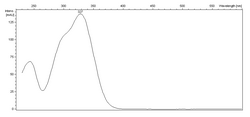葡萄反應產物
| 葡萄反應產物 | |
|---|---|

| |
| IUPAC名 2-[(E)-3-[3-[2-[(4-amino-4-carboxybutanoyl)amino]-3-(carboxymethylamino)-3-oxopropyl]sulfanyl-4,5-dihydroxyphenyl]prop-2-enoyl]oxy-3-hydroxybutanedioic acid | |
| 別名 | GRP GRP1 2-S-Glutathionyl caftaric acid 2-S-穀胱醯基咖啡醯酒石酸 |
| 識別 | |
| CAS號 | |
| PubChem | 71308212 |
| SMILES |
|
| ChEBI | 147433 |
| 性質 | |
| 化學式 | C23H27N3O15S |
| 摩爾質量 | 617.54 g·mol−1 |
| 若非註明,所有數據均出自標準狀態(25 ℃,100 kPa)下。 | |
葡萄反應產物(GRP、GRP1 或 2-S-谷硫醯基咖啡醯酒石酸)[1]是一種酚類化合物,可以解釋為什麼在加工過程中咖啡醯酒石酸會從葡萄汁中消失。[2]陳年紅葡萄酒中也含有這種成分。[3]它由多酚氧化酶酶解產生,對限制葡萄汁的褐變非常重要,[4]特別是在白葡萄酒生產中。 該產品可在模型解決方案中再現。[5][6]
通過質譜法可以確定其在葡萄酒中的濃度。[7]S-穀胱醯基咖啡醯酒石酸本身能被氧化。[8] 它不是葡萄多酚氧化酶的底物,但灰葡萄孢菌的漆酶可以利用它形成 GRP2。[9]
相關分子[編輯]
其他相關分子是「反式」-咖啡醯酒石酸衍生物,如 GRP1,2-苯醌[10]和 2,5-di-S-穀氨醯基咖啡醯酒石酸鹽(GRP2)[11]或與花青素的加合物。[12]

參考文獻[編輯]
- ^ Veronique F. Cheynier; Eugene K. Trousdale; Vernon L. Singleton; Michel J. Salgues; Renee Wylde. Characterization of 2-S-glutathionyl caftaric acid and its hydrolysis in relation to grape wines. J. Agric. Food Chem. 1986, 34 (2): 217–221. doi:10.1021/jf00068a016.
- ^ Caftaric acid in grapes and conversion to a reaction product during processing. V.L. Singleton, J. Zaya, E. Trousdale and M. Salgues, Vitis, 1984, pages 113-120 (article)
- ^ Anis Arnous; Dimitris P. Makris; Panagiotis Kefalas. Effect of Principal Polyphenolic Components in Relation to Antioxidant Characteristics of Aged Red Wines. J. Agric. Food Chem. 2001, 49 (12): 5736–5742. PMID 11743756. doi:10.1021/jf010827s.
- ^ V.L. Singleton; M. Salgues; J. Zaya; E. Trousdale. Caftaric Acid Disappearance and Conversion to Products of Enzymic Oxidation in Grape Must and Wine (PDF). Am. J. Enol. Vitic. 1985, 36 (1): 50.
- ^ V. Cheynier; C. Owe; J. Rigaud. Oxidation of Grape Juice Phenolic Compounds in Model Solutions. Journal of Food Science. 1988, 53 (6): 1729–1732. doi:10.1111/j.1365-2621.1988.tb07828.x.
- ^ Veronique Cheynier; Jorge M. Ricardo da Silva. Oxidation of grape procyanidins in model solutions containing trans-caffeoyltartaric acid and polyphenol oxidase. J. Agric. Food Chem. 1991, 39 (6): 1047–1049. doi:10.1021/jf00006a008.
- ^ Straightforward Method To Quantify GSH, GSSG, GRP, and Hydroxycinnamic Acids in Wines by UPLC-MRM-MS. Anna Vallverdú-Queralt, Arnaud Verbaere, Emmanuelle Meudec, Veronique Cheynier and Nicolas Sommerer, J. Agric. Food Chem. 2015, 63, 142−149, doi:10.1021/jf504383g
- ^ Caftaric Acid Disappearance and Conversion to Products of Enzymic Oxidation in Grape Must and Wine. V. L. Singleton, M. Salgues, J. Zaya and E. Trousdale, Am. J. Enol. Vitic, 1985, volume 36, number 1, pages 50-56 'abstract)
- ^ Salgues, M.; Cheynier, V.; Gunata, Z.; Wylde, R. Oxidation of Grape Juice 2-S-Glutathionyl Caffeoyl Tartaric Acid by Botrytis cinerea Laccase and Characterization of a New Substance: 2,5-di-S-Glutathionyl Caffeoyl Tartaric Acid. Journal of Food Science. 1986, 51 (5): 1191. doi:10.1111/j.1365-2621.1986.tb13081.x.
- ^ Cheynier V.; Rigaud J.; Souquet J.-M.; Duprat F.; Moutounet M. Must browning in relation to the behavior of phenolic compounds during oxidation. American Journal of Enology and Viticulture. 1990, 41 (4): 346–349.INIST:5402970
- ^ Véronique Cheynier; Jacques Rigaud; Michel Moutounet. Oxidation kinetics of trans-caffeoyltartrate and its glutathione derivatives in grape musts. Phytochemistry. 1990, 29 (6): 1751–1753. doi:10.1016/0031-9422(90)85008-4.
- ^ Petros Kneknopoulos; George K. Skouroumounis; Yoji Hayasaka; Dennis K. Taylor. New Phenolic Grape Skin Products from Vitis vinifera cv. Pinot Noir. J. Agric. Food Chem. 2011, 59 (3): 1005–1011. PMID 21214245. doi:10.1021/jf103682x.
| |||||||||||||||||||||||||||||||||||||||||||||||||||||||||||||||||
